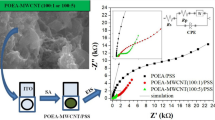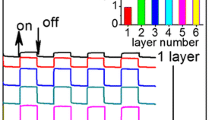Abstract
The electrochemically active polymers have been formed during electro-reduction carried out in solution containing fullerenes, C60 or C70, and transition metal complexes of Pd(II), Pt(II), Rh(III), and Ir(I). In these films, fullerene moieties are covalently bounded to transition metal atoms (Pd and Pt) or their complexes (Rh and Ir) to form a polymeric network. All films exhibit electrochemical activity at negative potentials due to the fullerene cages reduction process. For all studied metal complexes, yields of formation of films containing C70 are higher than yields of electrodeposition of their C60 analogs. C70 /M films also exhibit higher porosity in comparison to C60/M layers. The differences in film morphology and efficiency of polymer formation are responsible for differences in electrochemical responses of these films in acetonitrile containing supporting electrolyte only. C70/M films shows more reversible voltammeric behavior in negative potential range. They also show higher potential range of electrochemical stability. Processes of film formation and electrochemical properties of polymers depend on the transition metal ions or atoms bonding fullerene cages into polymeric network. The highest efficiency of polymerization was observed for fullerene/Pd and fullerene/Rh films. In the case of fullerene/Pd films, the charge transfer processes related to the fullerene moieties reduction in negative potential range exhibit the best reversibility among all of the studied systems. Capacitance performances of C60/Pd and C70/Pd films deposited on the porous Au/quartz electrode were also compared. Capacitance properties of both films are significantly affected by the conditions of electropolymerization. Only a fraction of the film having a direct contact with solution contributes to pseudocapacitance. Capacitance properties of these films also depend on the size of cations of supporting electrolyte. The C70/Pd film exhibits much better capacitance performance comparison to C60/Pd polymer.
















Similar content being viewed by others
References
Novak P, Muller K, Santhanam KSV, Haas O (1997) Chem Rev 97:207
Burke A (2000) J Power Sources 91:37
Wrighton MS (1986) Science 231:32
Fortier G, Brassard E, Belanger D (1990) Biosens Bioelectron 5:473
Yoshima H, Kobayashi M, Lee KB, Chung D, Heeger AJ, Wudl F (1987) J Electrochem Soc 134:46
Wudl F (2002) J Mater Chem 12:1959
Chen Y, Huang ZE, Cai RF, Yu BC (1998) Eur Polym J 34:137
Echegoyen L, Echegoyen LE (1998) Acc Chem Res 31:593
Winkler K, Balch AL, Kutner W (2006) J Solid State Electrochem 10:761
Gunes S, Neugebauer H, Sariciftci NS (2007) Chem Rev 107:1324
Rao CNR, Seshadri R, Govindaraj A, Sen R (1995) Mater Sci Eng R15:209
Wilson LJ, Cagle DW, Thrash TP, Kennel SJ, Mirzadeh S, Alford JM, Ehrhardt GJ (1999) Coord Chem Rev 190–192:199
Yeretzian C, Hansen K, Diedrich FN, Whetten RL (1992) Nature 359:44
Ito A, Morikawa T, Takahashi T (1993) Chem Phys Lett 211:333
Zhou P, Dong ZH, Rao A, Ecklund PC (1993) Chem Phys Lett 211:337
Takahashi N, Dock H, Matsuzawa N, Ata M (1993) J Appl Phys 74:5790
Yamawaki H, Yoshida M, Kakadate Y, Usuba S, Yokoi H, Fujiwara S, Aoki K, Ruoff R, Malhorta R, Lorents DC (1993) J Phys Chem 97:11161
Rao AM, Zhou P, Wang KA, Hager GT, Holden JM, Wang Y, Lee WT, Bi XX, Eklund PC, Cornett DC, Duncan MA, Amster IJ (1993) Science 250:955
Loy DA, Assink RA (1992) J Am Chem Soc 114:3977
Bunker CE, Lawson GE, Sun YP (1995) Macromolecules 28:7959
Cao T, Webber SE (1996) Macromolecules 29:3826
Ford WT, Graham TD, Mourey HT (1997) Macromolecules 30:6422
Hirsch A, Li Q, Wudl F (1991) Angew Chem Int Ed 30:1309
Sun YP, Liu B, Lawson GE (1997) Photochem Photobiol 66:301
Hawker CJ (1994) Macromolecules 27:4836
Rubin Y, Khan S, Freedberg D, Yeretzian C (1993) J Am Chem Soc 118:344
Fedurco M, Costa DA, Balch AL, Fawcett WR (1995) Angew Chem Int Ed Engl 34:194
Winkler K, Costa DA, Balch AL, Fawcett WR (1995) J Phys Chem 99:17431
Krinichnaya EP, Moravsky AP, Efimov O, Sobczak JW, Winkler K, Kutner W, Balch AL (2005) J Mater Chem 15:1468
Balch AL, Costa DA, Winkler K (1998) J Am Chem Soc 120:9614
Winkler K, de Bettencourt-Dias A, Balch AL (1999) Chem Mater 11:2265
Winkler K, de Bettencourt-Dias A, Balch AL (2000) Chem Mater 12:1386
Winkler K, Noworyta K, Kutner W, Balch AL (2000) J. Electrochem Soc 147:2597
Hayashi A, de Bettencourt-Dias A, Winkler K, Balch AL (2002) J Mater Chem 12:2116
Plonska ME, de Bettencourt-Dias A, Balch AL, Winkler K (2003) Mater Chem 15:4122
Plonska ME, Makar A, Winkler K, Balch AL (2004) Pol J Chem 78:1431
Winkler K, Plonska-Brzezinska ME, Gadde S, D’Souza F, Balch AL (2006) Electroanalysis 18:841
Winkler K, Grodzka E, D’Souza F, Balch AL (2007) J Electrochem Soc 154:K1
Forster D (1969) Inorg Nucl Chem Lett 5:433
Winkler K, Noworyta K, Sobczak JW, Wu CT, Chen LC, Kutner W, Balch AL (2003) J Mater Chem 23:518
Ward MD (1995) In: Rubinstein I (ed) Physical Electrochemistry. Marcel Dekker, New York Basel Hong Kong
Grodzka E, Nieciecka M, Winkler K (2008) J Solid State Electrochem 12:215
Acknowledgment
Support from the Polish State Committee for Scientific Research (grant N204 3747 33) is gratefully acknowledged.
Author information
Authors and Affiliations
Corresponding author
Rights and permissions
About this article
Cite this article
Grodzka, E., Grabowska, J., Wysocka-Żołopa, M. et al. Electrochemical formation and properties of two-component films of transition metal complexes and C60 or C70 . J Solid State Electrochem 12, 1267–1278 (2008). https://doi.org/10.1007/s10008-007-0490-2
Received:
Revised:
Accepted:
Published:
Issue Date:
DOI: https://doi.org/10.1007/s10008-007-0490-2




